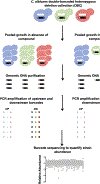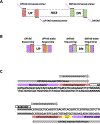Chemical-Genetic Approaches for Exploring Mode of Action of Antifungal Compounds in the Fungal Pathogen Candida albicans
- PMID: 37024700
- PMCID: PMC11019913
- DOI: 10.1007/978-1-0716-3155-3_10
Chemical-Genetic Approaches for Exploring Mode of Action of Antifungal Compounds in the Fungal Pathogen Candida albicans
Abstract
Candida albicans is a prevalent fungal pathogen of humans that can cause both superficial and life-threatening disease, primarily in immunocompromised populations. Currently, antifungal drug classes available to treat fungal infections remain limited and the emergence of drug-resistant strains threatens antifungal efficacy, necessitating the discovery and development of additional therapeutics. The construction of the C. albicans double-barcoded heterozygous deletion collection (DBC) enables the rapid and systematic assessment of haploinsufficiency phenotypes in a pooled format. Specifically, this functional genomics resource can be used to identify heterozygous deletion mutants that are hypersensitive to compounds in order to define putative cellular targets and/or other modifiers of compound activity. Here, we describe protocols to characterize the mode of action of small molecules using the C. albicans DBC, including how to prepare compound-treated cultures, isolate genomic DNA, amplify strain-specific barcodes, and prepare DNA libraries for high-throughput sequencing. This technique provides a powerful approach to elucidate the compound mechanism of action in order to bolster the antifungal pipeline.
Keywords: Antifungal; Candida albicans; Chemical genomics; Haploinsufficiency profiling; High-throughput sequencing; Molecular barcodes; PCR.
© 2023. The Author(s), under exclusive license to Springer Science+Business Media, LLC, part of Springer Nature.
Conflict of interest statement
Competing Interests
L.E.C. is a co-founder and shareholder in Bright Angel Therapeutics, a platform company for development of novel antifungal therapeutics. L.E.C. is a consultant for Boragen, a small-molecule development company focused on leveraging the unique chemical properties of boron chemistry for crop protection and animal health.
Figures






Similar articles
-
A chemical screen identifies structurally diverse metal chelators with activity against the fungal pathogen Candida albicans.Microbiol Spectr. 2024 Apr 2;12(4):e0409523. doi: 10.1128/spectrum.04095-23. Epub 2024 Feb 20. Microbiol Spectr. 2024. PMID: 38376363 Free PMC article.
-
New and Promising Chemotherapeutics for Emerging Infections Involving Drug-resistant Non-albicans Candida Species.Curr Top Med Chem. 2019;19(28):2527-2553. doi: 10.2174/1568026619666191025152412. Curr Top Med Chem. 2019. PMID: 31654512 Review.
-
Genome-wide fitness test and mechanism-of-action studies of inhibitory compounds in Candida albicans.PLoS Pathog. 2007 Jun;3(6):e92. doi: 10.1371/journal.ppat.0030092. PLoS Pathog. 2007. PMID: 17604452 Free PMC article.
-
Chemical-genetic approaches for exploring the mode of action of natural products.Prog Drug Res. 2008;66:237, 239-71. doi: 10.1007/978-3-7643-8595-8_5. Prog Drug Res. 2008. PMID: 18416308 Review.
-
Small molecules restore azole activity against drug-tolerant and drug-resistant Candida isolates.mBio. 2023 Aug 31;14(4):e0047923. doi: 10.1128/mbio.00479-23. Epub 2023 Jun 16. mBio. 2023. PMID: 37326546 Free PMC article.
Cited by
-
Transcriptomic meta-analysis to identify potential antifungal targets in Candida albicans.BMC Microbiol. 2024 Feb 27;24(1):66. doi: 10.1186/s12866-024-03213-8. BMC Microbiol. 2024. PMID: 38413885 Free PMC article.
-
Systematic analysis of the Candida albicans kinome reveals environmentally contingent protein kinase-mediated regulation of filamentation and biofilm formation in vitro and in vivo.mBio. 2024 Aug 14;15(8):e0124924. doi: 10.1128/mbio.01249-24. Epub 2024 Jul 1. mBio. 2024. PMID: 38949302 Free PMC article.
-
The GPCR antagonist PPTN synergizes with caspofungin providing increased fungicidal activity against Aspergillus fumigatus.Microbiol Spectr. 2025 Mar 17;13(5):e0331824. doi: 10.1128/spectrum.03318-24. Online ahead of print. Microbiol Spectr. 2025. PMID: 40090930 Free PMC article.
References
Publication types
MeSH terms
Substances
Grants and funding
LinkOut - more resources
Full Text Sources
Medical

